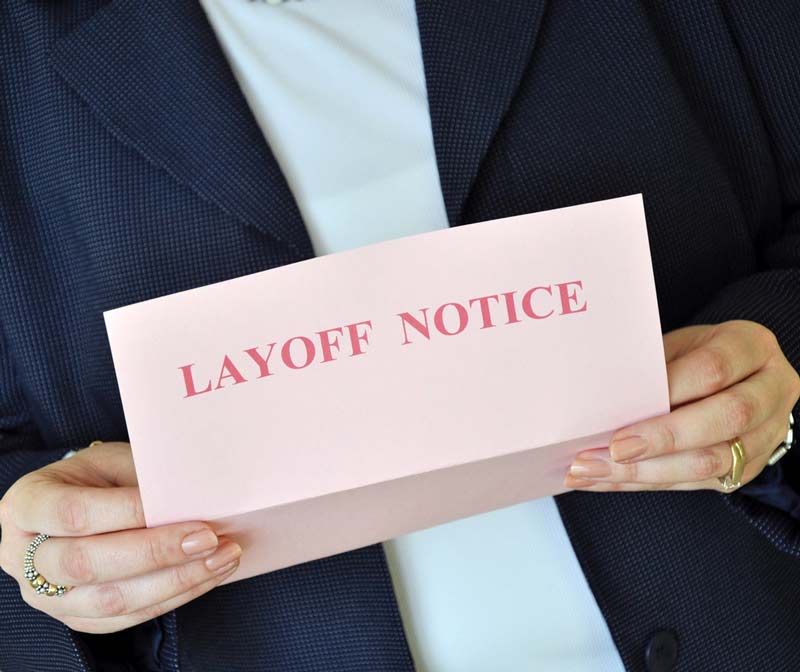Layoffs are a common experience — 40% of workers report having been laid off at least once and according to the Bureau of Labor Statistics, nearly 1.6 million workers were laid off in July 2023 alone.
Knowing what to do if the ax falls will put you in the best position to rebound.
Some suggestions worth investigating:
- Ask HR for a “laid-off” letter
- Ask about insurance coverage
- Check on your final paycheck
- Review your 401k contributions
- Ask about severance
- File for unemployment
- Put the internet to work for you
- Update your resume
- Print personal business cards
- Start your job search
There are things you must do when laid off.
And one thing you must not, and it applies to the ensuing checklist:
“Don’t immediately sign anything the company asks you to,” says 25-year corporate veteran Colin McLetchie, president of Arlington, Va.-based professional coaching consultancy Five Ways Forward. “Find out how much time you have to review materials, and take some of that time to make sure everything is clear.
“Whether you can negotiate anything has a lot to do with factors outside your control – so prioritize your asks, work with a lawyer or other expert, and make your asks in time for them to be considered before the signing deadline.”
1. Request a ‘Laid-Off Letter’ from Human Resources
Assuming you have not been terminated for cause, but, rather, your job has been eliminated for reasons outside your influence — restructuring, economic reversals, mergers, buyouts, relocations, and so on — a layoff letter explaining the circumstances to you (and prospective employers) most likely will be part of your farewell package.
Read it carefully for errors or omissions. If the letter gets a significant detail relating to your division wrong, or it overlooks an important contribution made by you or your team, do not hesitate to point it out and ask, politely, for a revision.
If you don’t receive a layoff letter, ask for one. It’s one thing to tell prospective employers that you were part of a reduction-in-force, and quite another to be able to provide evidence that you were not simply fired.
On that note, the Human Resources department will not have to start from scratch. The internet offers lots of well-reviewed layoff letter templates to help get them started.
Beyond a simple layoff letter, “Ask for a recommendation or referral from your previous employer,” says Lilia Stoyanov, CEO of Transformity, an HR software and freelance platform.
2. Inquire About Your Health Insurance Benefit
After a layoff, how long you are covered under your employer-sponsored plan hinges on how far in advance your premiums are paid. Typically, employers pay a single month in advance, which is welcome news for those laid off early in the month, not so much for those laid off near the end.
Among other details, your package should lay out your health insurance status and options, but don’t be shy about having the details clarified to your satisfaction.
Going without health insurance is a risky bet, although it’s less onerous now. As part of the 2017 Tax Cuts and Jobs Act, Congress zeroed out the Affordable Care Act’s individual mandate penalty (effective 2019); if you find yourself without coverage, at least you won’t be facing a looming IRS fine.
Health Benefits Option No. 1: If you were laid off from a company with 20 or more employees the prior year, COBRA — the Consolidated Omnibus Budget Reconciliation Act — allows you to continue coverage for you and your family for up to 18 months. However, you may be required to pay the entire premium, up to 102% of the cost to the plan.
Health Benefits Option No. 2: Under ACA, you may shop for an individual health care plan on the state or federal exchanges. With your income temporarily slashed, you may qualify for a substantial subsidy. Don’t worry if it’s not open enrollment time; losing your job counts as one of those unforeseen life events that allow you to apply midyear.
3. Collect — Or Check On — Your Final Paycheck
Depending on the circumstances of your layoff, you may receive your final paycheck the same day you are separated from the company. Make certain it’s for the correct amount, and that all the deductions are in order.
While you’re at it, break out the employee handbook to find out how the company treats unused vacation/sick days or PTO (paid time off). Washington is silent on paying off unspent vacation days, and state laws vary; nonetheless, many companies compensate for banked vacation/PTO, having held it as a liability against their books in the first place.
If you are part of a mass layoff — certain restrictions apply — you won’t be getting a final paycheck for a couple of months. The federal Worker Adjustment and Retraining Notification Act (WARN Act) requires employers to provide 60 days’ notice, during which all wages and benefits will continue to flow as usual, giving those who were laid off at least a little time to brace for unemployment, or get busy finding that new (better — knock wood) job.
4. Review Your 401(k) and/or Pension Plans
If you had a 401(k) with your former employer, you have options.
- Leave it in your former employer’s plan. If you have at least $5,000 in your account, chances are you can let it sit invested right where it is. Consider this a temporary solution.
- If your next employer offers a 401(k) plan, find out whether you have the option to consolidate your old plan with the new one. If so, you’ll get your retirement investments back under one roof without suffering tax penalties.
- Open a rollover IRA (individual retirement account), and drop you old 401(k) there. You can choose from a wide variety of investment options — stocks, bonds, mutual funds, real estate investment trusts, and so on — or you may simply select a “lifecycle fund,” which bases investments on your target retirement date.
- Cash out your 401(k). We mention this only because it is an option, although it’s a lousy one. Not only will you injure your retirement plan, perhaps beyond repair, you will pay a premium for grabbing the money now: federal (and, where applicable), state, and local income taxes will be due on the lump sum, plus a 10% penalty for early withdrawal.
If your company offered a traditional defined-benefit plan — that is, you work a certain number of years at a certain salary level, and at retirement you can expect a predictable monthly payout — you may have options here, too.
Much of your decision will pivot on how old you are and how long you’ve been with the company. For those not fully vested — that is, they weren’t with the employer long enough to qualify for full retirement benefits — it might be wise to take a lump-sum payout, if offered … but don’t spend it! Instead, invest it in a rollover IRA and let it grow.
Closer to retirement? If you’re vested and research indicates your former company is on firm financial footing, and you fancy the idea of regular payments, you could be happier waiting for your annuity to kick in.
» Learn More: Saving and Investing for Life
5. Investigate a Severance Package
Oftentimes, there’s little wiggle room here. Most companies will have had their severance packages (if any) reviewed by legal staff, and unless the work is sloppy, what you’re offered probably is what you’ll get.
Still, do yourself a solid and carefully inspect the details. Consult an attorney specializing in labor law if you suspect the package falls short of industry standards.
Ask what’s behind the layoffs and try to find out who is being eliminated. Does the company appear to be targeting readily identifiable groups? Older workers, sex, race, national origin?
Have you been singled out for demographic reasons? Can you cite the ways you’ve been treated differently? If you can mount a plausible discrimination claim, it could bolster your negotiating position.
If the company won’t budge on its payout, and your leverage is minimal, ask about other areas of help: a letter of recommendation; a guarantee that your former supervisors will provide good references when potential employers call; help with outplacement services; and a set time period your company email and voicemail will remain in service.
6. Register for Unemployment
As a former employee in good standing, you have earned unemployment benefits. Accessing those benefits will take some pressure off your emergency fund, so sign up as soon as is feasible. Find out whether you’re entitled to the weekly $300 federal bonus that runs through September as part of the 2021 American Rescue Plan Act.
Keep in mind, your eligibility, the amount you’ll receive, and the length of time you’re covered (oftentimes 26 weeks) depends on where you live. Check with the local branch of your state’s Department of Labor and the unemployment office.
More than likely, you can apply online.
7. Put the Internet to Work for You
There never has been more truth to the cynical maxim, It’s not what you know; it’s who you know. Effective networking is key to the optimal job pursuit.
And you’re going to do a lot of it online.
“Being digitally-savvy has becoming increasingly important,” says Kane Carpenter, Director, Career Services, Employment BOOST. “Understand how to play the game: Making sure your resume is getting through applicant tracking systems (ATS) and making an impression requires an understanding of technology.
“And the use of social media as a visibility tool has become increasingly prevalent.”
These days, LinkedIn is your online network, a digital lifeline offering a readymade conduit for effectively and efficiently spreading the news that you’re looking for that next challenge. Recruiters, especially, prefer LinkedIn over other social networks: 94% who use (or intend to use) social media for recruiting use LinkedIn — 30 points higher than the runner-up, Facebook.
Update your status, provide a fresh introduction, and review your listed strengths and skills. Beef up the descriptions of your past jobs and achievements; stress your experience and accomplishments with an eye to your future.
Don’t be shy about messaging contacts with whom you have close personal or professional ties, and follow with off-line connections.
“While it’s still rare to be offered a job right away on LinkedIn,” Carpenter says, “you do see individuals reach out to their networks and get put in contact with the right people.
“At that point the traditional job search ensues, but that initial contact – or gatekeeper – is easily reachable with social media.”
Do not stop there. Job-search websites can help match your skills, experience, and ambitions with the perfect opportunity. Among the best-rated are Indeed and Monster. Experienced managers should check out The Ladders. If you’re an hourly worker, check out Snagajob.
But do not neglect the personal touch, says San Francisco-based networking strategy coach Stephanie Thoma: “Technology has greatly changed job hunting since the Great Recession, and face-to-face communication and networking can be seen as more novel when it was once the norm.
“Take this opportunity to get face time with people at networking events, targeting attending events at the HQ of a company you’d like to work for, or where they are a sponsor or have a speaker on the panel.”
While you’re at it, scrub your other social media accounts of embarrassing, compromising, or merely unprofessional posts.
8. Reinvigorate Your Resume
If you’re not someone who routinely reviews and updates his/her resume, now is the time. Considering a career change? You’re not alone; the pandemic forced millions of Americans to reassess their careers. If this includes you, you may want to shift what you emphasize.
Don’t know how to begin? Type “resume builder” into your favorite search engine, and off you go.
Uncertain what your strengths are? Ask coworkers, friends, and other associates for an honest evaluation. They may see qualities you have overlooked.
9. Print Personal Business Cards
For this moment, at least, you have a new career: Professional job-seeker. Treat it like you would any sole proprietorship or LLC with unique branding, including personal business cards. Don’t even think about using cards from your former company with scratch-outs and handwritten updates.
Include your name, non-work telephone number, specialty email address (set up an account exclusive to your job search), a target job title, (Senior Customer Opportunity Manager; Director of Troubleshooting), a unique branding statement, and your LinkedIn profile URL.
10. Start Your Job Search
We probably should have mentioned this at the top: Take a breath. You have suffered a terrible blow, and you hurt. Probably, you’re angry.
It’s OK to grieve the loss of your job, especially when you ultimately had no power to influence events.
“When you’re laid off,” says Keri Ohlrich, author and CEO of Los Angeles-based HR consultants Abbracci Group, “ it’s important to embrace the way you feel and surrender to feeling sad, excited, angry or whatever emotion you’re feeling.”
But as you grieve and angrily vent to your closest confidants, moderate to the rest of the world what you say about your former employer. Even as you work through the hurt, muster as much professional class as you can to put the totality of your experience in a positive light: what you learned, what you achieved, the colleagues you supported and who supported you, and why you’re a better employee for the experience.
In the early stages, there’s not much over which you have ultimate influence, except the attitude you show the world. Show it an attitude it would like to work alongside.
As you grapple with this new reality, think hard about what you want to do next (it may be a completely new direction), how to position yourself for that opportunity (maybe take a class to hone or acquire a skill), understand your transferable skills, cultivate your network, study how to become the best interview you can be.
“If, during the interview,” Transformity’s Stoyanov says, “you are asked if you have been laid off, don’t try to avoid the question or provide a vague answer. Instead, be prepared and explain that the company needed to lay off a number of employees due to sluggish sales, losing market share, etc.”
Remember, you have your layoff letter as evidence.
Also, Stoyanov says, rehearse how you’ll answer the trickier question: “’Why were you among those who were laid off and not among those who stayed?” This is a question about your perceived weaknesses dressed up in other clothes.
Now, let your friends and social media networks know you’re in the market for that next opportunity. Email friends. Post an upbeat message across all your platforms. Don’t fret about being idled; everyone understands about layoffs.
Unemployment is sinking. Wages are inching up once more. And workers are in the driver’s seat. “Finding qualified employees remains the biggest challenge for small businesses and is slowing economic growth,” NFIB chief economist Bill Dunkelberg told the Wall Street Journal. “Owners are raising compensation, offering bonuses and benefits to attract the right employees.”
Play this right and ultimately you may come to see the dark day you lost your job as the springboard to the career you always wanted.
Keep this in mind, also, says layoff-veteran-turned-inspirational-speaker John Livesay: “I am still the same person whether I am being laid off or winning an award. My advice for people is to not let your self-esteem go on a rollercoaster ride based on the highs and lows of your career.”
Get Help If You Are Struggling Financially
Losing a job can be a challenging experience, often leading to financial difficulties. If you find yourself in that situation, consider going through a free credit counseling session. Credit counselors can help with creating a budget and offer guidance on debt relief solutions if needed. Their expertise can help you get a handle on your finances and navigate the financial difficulties that often come after losing your job.
Useful Resources If You Have Been Laid Off
Check out these resources to help you through the various aspects of job loss:

14 MINUTE READ
Home » InCharge Blog »
Sources:
- N.A. (2019, August 15) Study Finds Nearly Half of Employees Experience Layoff Anxiety Despite Record Low Unemployment Rates and Upward Economic Growth. Retrieved from https://www.prnewswire.com/news-releases/study-finds-nearly-half-of-employees-experience-layoff-anxiety-despite-record-low-unemployment-rates-and-upward-economic-growth-300902079.html
- N.A. (N.D.) Table 5. Layoffs and discharges levels and rates by industry and region, seasonally adjusted. Retrieved from https://www.bls.gov/news.release/jolts.t05.htm
- Morath, E. (2021, May 11) U.S. Job Openings Reach Record as Hiring Slows. Retrieved from https://www.wsj.com/articles/job-openings-rise-despite-hiring-slowdown-11620725400
- N.A. (2021, May 26) Layoffs at Rhode Island factory as demand for N95 masks ebbs. Retrieved from https://apnews.com/article/donald-trump-rhode-island-coronavirus-pandemic-layoffs-business-127f58458b4844c0ffbf92dbf555b571
- N.A. (2021, May 15) 1,600 layoffs coming at Illinois Jeep Cherokee factory. Retrieved from https://apnews.com/article/illinois-layoffs-business-659bba63f6fb2f9f8931303f68cd4efa
- Reilly, M. (2021, June 3) General Mills begins job cuts in post-pandemic restructuring. Retrieved from https://www.bizjournals.com/twincities/news/2021/06/03/general-mills-2021-restructuring-job-cuts.html
- Cummins, I. (2015, February 12) One in five suicides caused by unemployment but the lead-up to lay-off hurts most. Retrieved from https://theconversation.com/one-in-five-suicides-caused-by-unemployment-but-the-lead-up-to-lay-off-hurts-most-37530
- Ju, S. (2019, August 15) 19 Fascinating Stats on Layoff Anxiety — Infographic. Retrieved from https://www.careerarc.com/blog/2019/08/19-fascinating-stats-on-layoff-anxiety-infographic/
- N.A. (ND) Continuation of Health Coverage — COBRA. Retrieved from https://www.dol.gov/general/topic/health-plans/cobra
- Green, A. (2019, July 9) What to Do If You Were Just Laid Off. Retrieved from https://www.thecut.com/article/laid-off-what-to-do.html
- Joyce, S.P. (ND) LinkedIn Job Search Guide. Retrieved from https://www.job-hunt.org/linkedin-job-search/LinkedIn-job-search.shtml

















